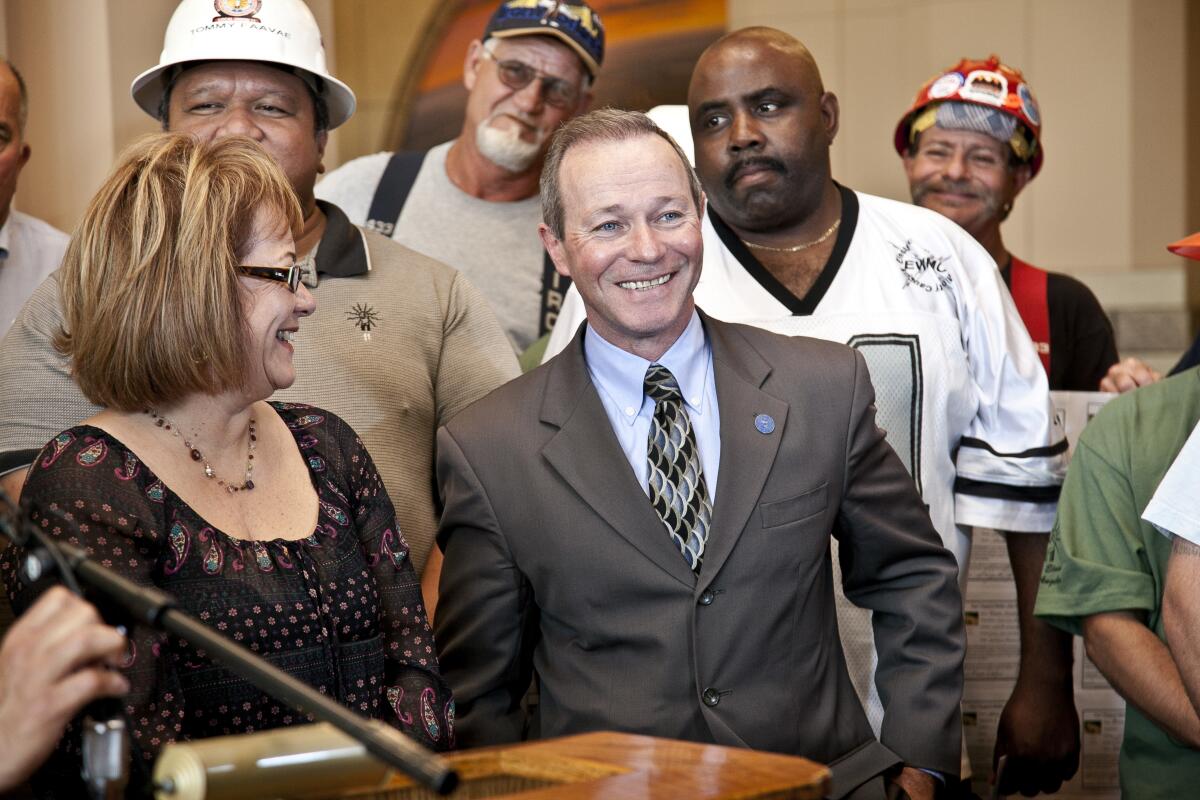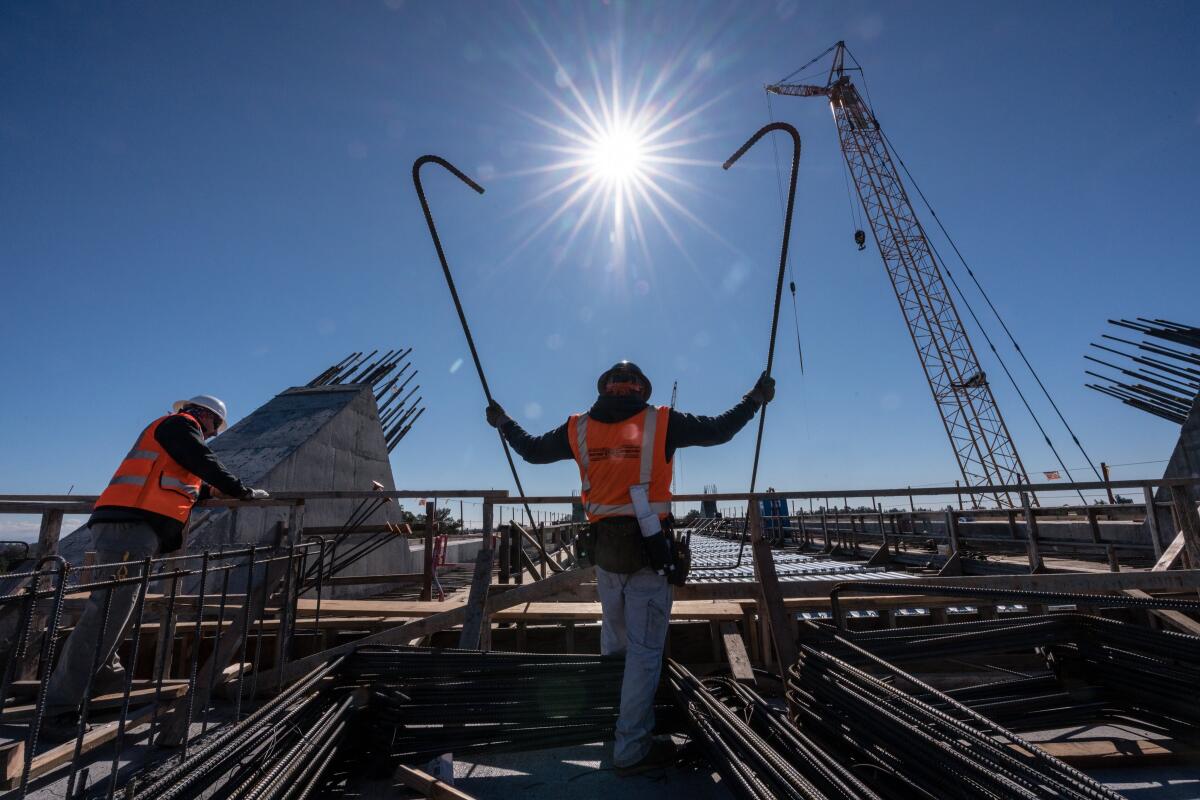Unions are the powerhouse behind Californiaâs troubled bullet train. A big test awaits

The brawny bodies with yellow hardhats and orange vests have been hard to miss in the audience over the years at California bullet train board meetings, legislative hearings and other key events.
They are sending a clear message that organized labor supports the massive $100-billion project and wants lawmakers, rail board directors and other state officials to stick with it.
For the record:
4:30 p.m. June 9, 2021An earlier version of this article incorrectly reported a California High-Speed Rail Authority vote on a consultantâs study supportive of starting work in the Central Valley. Three of nine members voted against the plan, not three of 11 members.
Among union officials, Robbie Hunter, head of the 450,000-strong State Building and Construction Trades Council of California, has wielded significant clout in keeping the project moving, despite its constant problems with funding and engineering. The unions were one of the key reasons that Gov. Gavin Newsom threw his support behind high-speed rail.
The project is short some $80 billion, according to current estimates, and is so far behind schedule that no one can even say with much confidence if it will ever be finished. Management turmoil and problems in securing land for the rail line have turned the project into a case study of a flawed mega-project.
Despite the problems, Hunter has been a firm backer: âWe do believe in it,â he said.
Hunter is now among those pushing the Legislature to release the remaining $4.2 billion of the $9 billion that voters approved in 2008 for high-speed rail. The rail authority wants virtually all the money for a standalone, 171-mile segment of rail that will run between Bakersfield and Merced â a huge blessing for 1,000 construction hardhats in the often-overlooked San Joaquin Valley. Even that money will only pay for building part of that segment, which along with investments in urban areas and and environmental clearances is now estimated to cost $22.8 billion.
The San Joaquin Valley plan enjoys support from key players, including Democrats from the region, House Speaker Nancy Pelosi and Newsom. Many political analysts expect Vice President Kamala Harris to help secure money.
Hunterâs position has set him against a growing majority of legislators who want to reallocate a chunk of money to bullet train segments in Southern California and the Bay Area. Speaker Anthony Rendon (D-Lakewood) said he wants earlier and larger benefits for the stateâs population centers.
In the next month, Hunterâs political power, along with the clout of Carpenters, Teamsters and others, will be put to the test as the state and federal government begin doling out transportation dollars.
âLabor unions are always critical to the political support of any kind of infrastructure project,â said Rob Stutzman, a Sacramento political consultant and former aide to Gov. Arnold Schwarzenegger. âThey have been critical to keeping support of the high-speed rail project as it has evolved or devolved to its current condition.â
But a recent public opinion poll conducted by the Democratic Caucus showed a large majority of the public is now opposed to the project. Key budget committee leaders are turning up the heat, as well.
âIf anything, there are more people critical of the program now than in the past,â Rendon said in an interview.
The financial path forward is full of crooked tracks. Even as President Biden unveiled his then $2-trillion federal investment in transportation and infrastructure in late March, he made no mention of Californiaâs bullet train.
When Newsom recently outlined a massive spending program from the proceeds of an unexpected surge in tax revenue, not a single million went into the bullet train.
Much rides on how passionately the project is viewed by the unions.
In Sacramento, Hunterâs trade council â which includes unions representing iron workers, operating engineers and laborers â gives millions of dollars to candidates and ballot measures, and helps protect prevailing wages for worker and project labor agreements. It helped defeat a 2016 measure, Prop. 53, which would have required voter approval before the state could sell large amounts of revenue bonds for infrastructure.
Hunterâs clout was clear earlier this year when he managed to kill legislation that would have increased oversight on the bullet train. Assemblywoman Laura Friedman (D-Burbank), chair of the Transportation Committee, introduced legislation that would have allowed the nonpartisan Legislative Analystâs Office to review any document that was given to the rail authority, a power it does not currently have. Hunterâs labor organization and others called Friedman and lambasted the idea as bureaucratic, according to a member of the Assembly.
âNobody wants to get a call like that from Robbie Hunter,â the lawmaker said. It was promptly withdrawn. Friedman declined to comment.
Brian Kelly, chief executive of the California High-Speed Rail Authority, said he counts on Hunterâs political support, adding that union jobs in the economically distressed Central Valley are important. âIt is about survival,â he said.
Still, maintaining support for the project has been a struggle. When the bond measure was passed in 2008, voters were promised that the bullet train would be operating between Los Angeles and San Francisco by 2020 at a cost of $33 billion. Today, the estimated cost is $100 billion with no set completion date.
As a result, the flow of money has become unpredictable.
Biden wants to see that California is fully committed to the project by appropriating the remaining $4.2 billion, according to one senior California legislator speaking on background. Meanwhile, Newsom is waiting to see whether Biden is going to deliver on a significant amount of money to the project out of his infrastructure plan, assuming it gets passed by Congress.
âThey are watching us to see what we are going to do, and we are watching them to see what they are going to do,â said a senior California legislator, speaking on background. âIt is a question of who blinks first.â
One possible outcome is that the Legislature will not appropriate all of the money Newsom wants, and Congress will not appropriate all of the massive infrastructure program that Biden has supported, meaning the California bullet train will lurch along for the foreseeable future in extended uncertainty.

Where the state Senate stands is unclear. Senate President Pro Tem Toni Atkins (D-San Diego) has never made her views explicit. The new chair of the Senate Transportation Committee, Lena Gonzales (D-Long Beach) has carefully avoided saying anything as well. But at a March 16 hearing, Sen. Maria Elena Durazo (D-Los Angeles), chair of the Senate budget subcommittee for transportation, called the rail authorityâs past planning âirresponsibleâ and said the current plan is just âwishful thinking.â
For years, Assemblyman Richard Bloom (D-Santa Monica), chairman of the Assembly budget subcommittee on transportation, has supported the bullet train and much of the vision that Newsom and former Gov. Jerry Brown laid out. Today, Bloom said in an interview that he is open to alternative ideas about how to build the system, signaling he may back others in the Assembly who want to shift some funding to coastal segments of the bullet train.
âAll options deserve to be considered, and this is one of them,â he said.
The argument that Kelly and other supporters make is simple enough: If the state doesnât finish even a portion of an electrified high-speed rail segment in coming years, it may never get another opportunity, and an actual operating system will stoke the public appetite for an expansion. The rail authority cites a study by a consultant that concluded the Central Valley plan would yield the highest benefits.
Opponents say the study was deeply biased. Notably, three of the nine members of the rail authority board voted against the plan in March.
Banners in the Central Valley proclaim thousands of jobs created by the high-speed rail project. The real numbers are more complicated.
Hunter maintains he is supporting the best plan. âI am doing my best to build things that we need, not build because we want jobs,â Hunter said.
When asked about shifting money out of the Central Valley, even if it brought more union jobs in urban areas, Hunter said, âI donât know. We would have to look at the logistics and the efficiencies. The incentive is to get a real length of the Central Valley moving and open a route to Silicon Valley.â
Another force involved is the Teamsters, which represents concrete workers and would operate future trains. It backs the Central Valley plan.
A decade ago, the national organization adopted a resolution supporting the California project, and it will renew that this year, said David Cameron, assistant to the director of the Teamsters Rail Conference and a member of the Biden transition team for passenger rail.
âWe have daily calls with people on the Hill,â Cameron said.
The Carpenters, a union that is not part of Hunterâs organization, is somewhat more open to a new direction.
âI can see both arguments,â said Dan Langford, executive secretary and treasurer of the carpenters council in Southern California and parts of six other states with a membership of 50,000 workers. âIt makes sense to have high-speed rail where it is most needed. Either way, it creates opportunity for members.â
More to Read
Sign up for Essential California
The most important California stories and recommendations in your inbox every morning.
You may occasionally receive promotional content from the Los Angeles Times.











